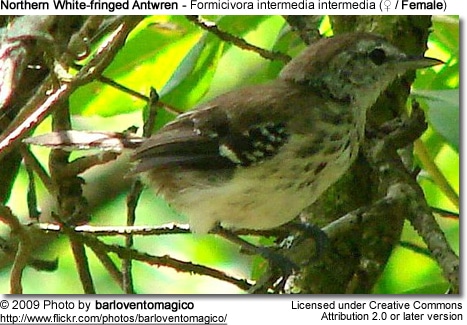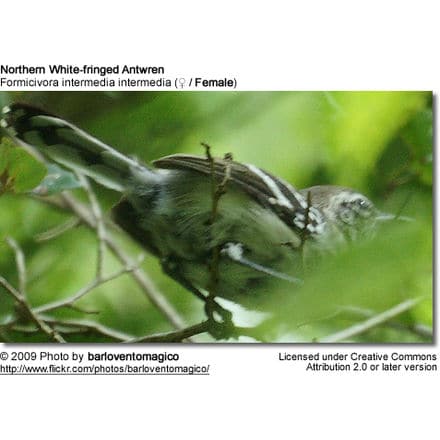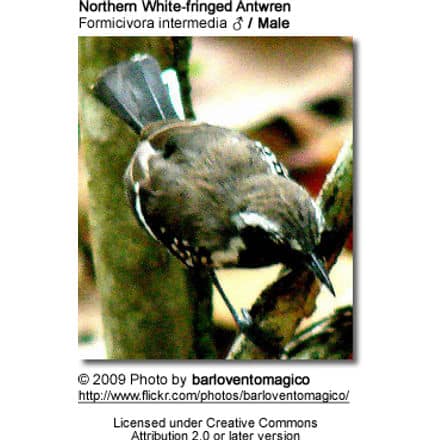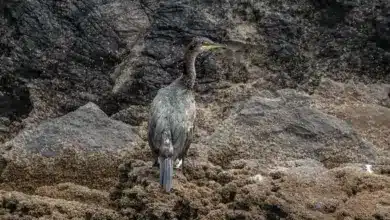White-fringed Antwrens
The White-fringed Antwrens, Formicivora grisea, is a passerine bird in the antbird family.
Distribution / Range
It is a resident breeder in tropical South America from Colombia southeast to the Guianas and Brazil and on Tobago.
This is a common and confiding bird of second-growth woodland, usually found as territorial pairs. The southern populations are associated with scrubby bushes on white sandy soils and restinga habitat. These birds inhabit the lowlands, up to around 200 meters above sea level (ASL). In some places, they are sympatric with the Rusty-backed Antwren (F. rufa).
Description
The White-fringed Antwrens is typically 12.7 cm long and weighs 9.4 g.
The male has a grey-brown crown and upperparts, and black wings, tail, lower face and underparts. There are two conspicuous white wing bars and a white stripe running from above the eye down the sides of the breast and flanks. The tail feathers are tipped with white.
The female’s upperparts are much like the male, but females of the southern populations are orange below and have an orange supercilium (line above each eye). These occur south and east from southeastern Colombia and southernmost Venezuela.
Northern population’s females have underparts which are buff with dark streaks. The Tobagonian subspecies F. g. tobagensis is larger than mainland birds.
![Northern White-fringed Antwren] (Formicivora intermedia) (♂) - Male](https://earthlife.net/wp-content/uploads/NorthernWhitefringedAntwrenmale_Z4eEu12DL-1-1.jpg)
Calls / Vocalizations
It has a tu whistle followed by a trilled churet, and a repeated and accelerating tu-ik call. Southern birds also have a repetitive chump-chump-chump song, quite unlike northern races which are sometimes separated as Northern White-fringed Antwren (Formicivora intermedia). F. grisea proper would then become the Southern White-fringed Antwren.
Diet / Feeding
The White-fringed Antwrens feeds on small insects and other arthropods taken from undergrowth twigs and foliage.
Breeding / Nesting
The female lays two purple-marked creamy white eggs, which are incubated by both sexes, in a grass hammock nest low in a tree or shrub.
Nests are occasionally plundered by predators, for example smallish mammals like the Common Marmoset (Callithrix jacchus), despite the birds’ attempts to defend their offspring.


Status
Of a total of 13 birds studied in Colombia – in the Parque Nacional de La Macarena and near Turbo –, only one was infected with blood parasites (an undetermined Plasmodium species).
This bird is not considered globally threatened by the IUCN. However, its resilience to human alteration of habitat is not too pronounced, and in some regions its continuing presence would seem to depend on protection of habitat.
Antbird Information … Antbird Species





